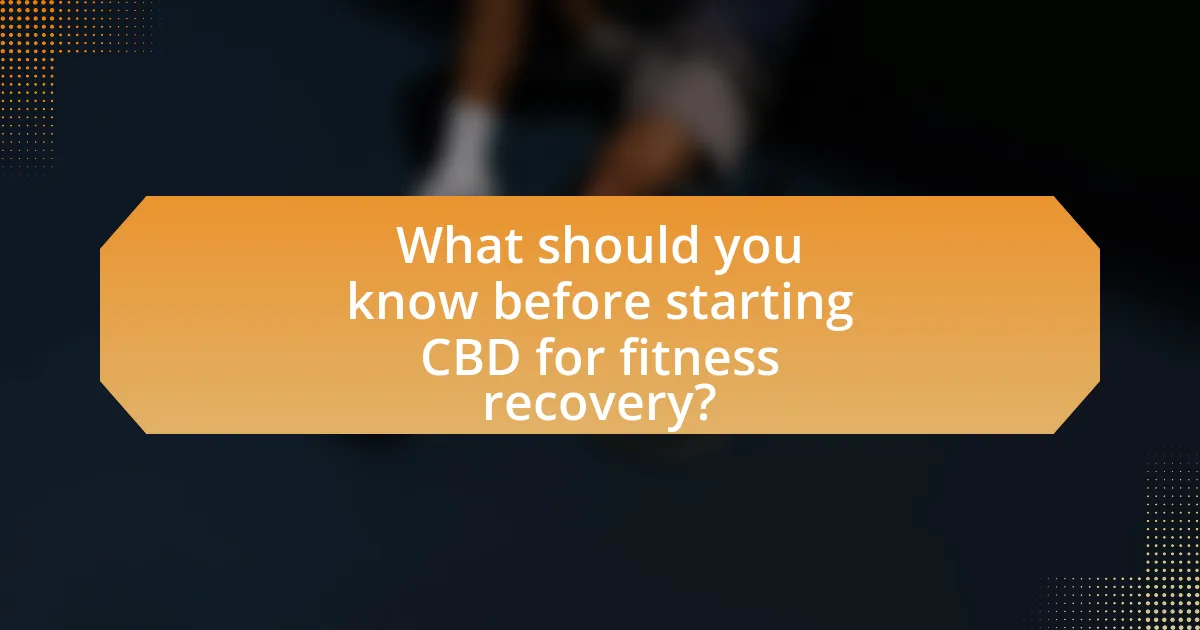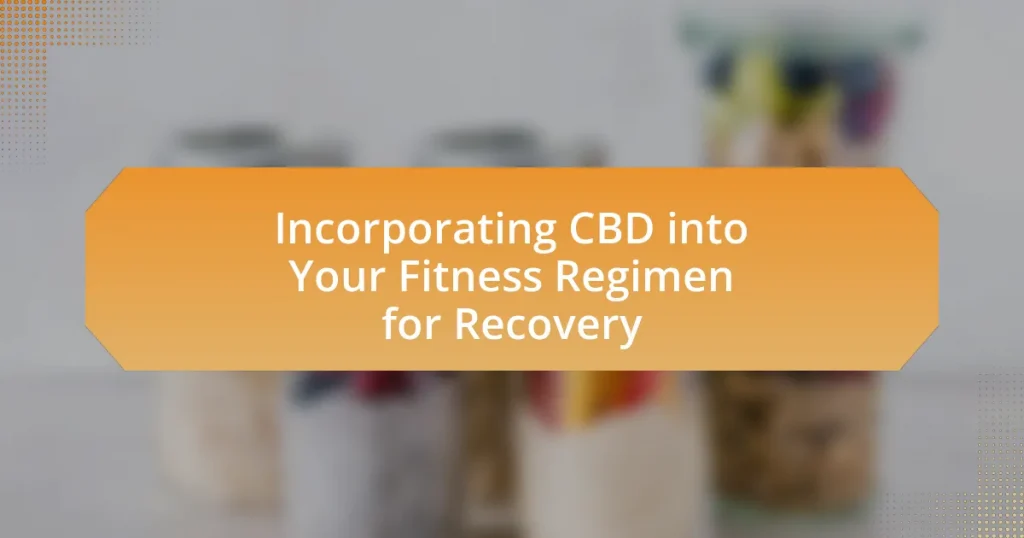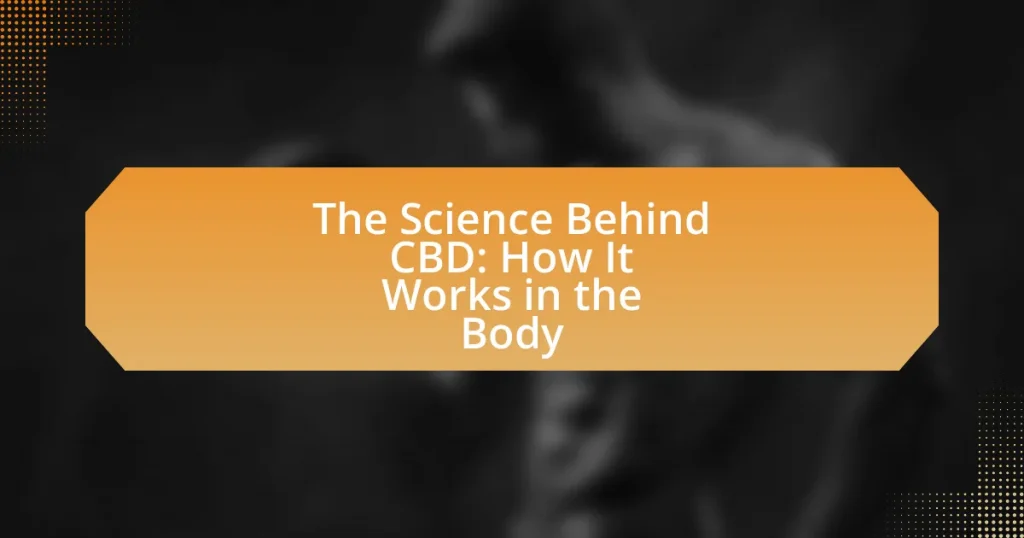CBD, or cannabidiol, is a non-psychoactive compound from the cannabis plant recognized for its potential therapeutic benefits, particularly in pain relief and inflammation reduction. This article explores how athletes can effectively incorporate CBD into their fitness regimens for recovery, detailing its various forms, legal considerations, and interaction with the body’s endocannabinoid system. Key benefits include reduced muscle soreness, improved sleep quality, and enhanced recovery times, supported by scientific research. Additionally, the article outlines recommended dosages, consumption methods, and best practices for integrating CBD into fitness routines, while also addressing potential side effects and precautions.

What is CBD and how can it be incorporated into a fitness regimen for recovery?
CBD, or cannabidiol, is a non-psychoactive compound derived from the cannabis plant known for its potential therapeutic benefits, including pain relief and anti-inflammatory properties. Athletes can incorporate CBD into their fitness regimen for recovery by using products such as oils, capsules, or topical creams post-workout to alleviate muscle soreness and reduce inflammation. Research indicates that CBD may help in managing exercise-induced inflammation and pain, as evidenced by a study published in the Journal of Pain Research, which found that CBD significantly reduced pain and improved recovery times in participants.
What is CBD and what are its properties?
CBD, or cannabidiol, is a compound derived from the cannabis plant known for its therapeutic properties. It interacts with the body’s endocannabinoid system, which plays a crucial role in regulating various physiological processes such as pain, mood, and inflammation. Research indicates that CBD possesses anti-inflammatory, analgesic, and anxiolytic properties, making it beneficial for recovery in fitness regimens. For instance, a study published in the Journal of Pain Research found that CBD can significantly reduce pain and inflammation in animal models, supporting its use for post-exercise recovery.
How is CBD derived and what forms does it come in?
CBD, or cannabidiol, is derived primarily from the hemp plant, specifically from its flowers, leaves, and stalks. The extraction process typically involves methods such as CO2 extraction, which preserves the purity and potency of the compound, or solvent extraction, which uses alcohol or other solvents to isolate CBD.
CBD is available in various forms, including oils, tinctures, capsules, edibles, topicals, and vapes. Each form offers different methods of consumption and absorption, catering to individual preferences and needs. For instance, oils and tinctures allow for quick absorption, while topicals provide localized relief.
What are the legal considerations surrounding CBD use?
The legal considerations surrounding CBD use primarily involve its classification and regulation under federal and state laws. In the United States, the 2018 Farm Bill legalized hemp-derived CBD containing less than 0.3% THC, allowing for its sale and use, but individual states may impose stricter regulations. For instance, some states have specific licensing requirements for CBD products, while others may restrict its use in food and beverages. Additionally, the FDA has not approved CBD for dietary supplements or food additives, creating a complex legal landscape that requires consumers and businesses to stay informed about local laws and regulations.
How does CBD interact with the body during recovery?
CBD interacts with the body during recovery primarily through its effects on the endocannabinoid system, which plays a crucial role in regulating pain, inflammation, and immune response. Research indicates that CBD can reduce inflammation by inhibiting the production of pro-inflammatory cytokines and promoting the release of anti-inflammatory mediators. A study published in the Journal of Experimental Medicine found that CBD significantly reduced chronic inflammatory and neuropathic pain in rodents, suggesting its potential for alleviating pain during recovery. Additionally, CBD may enhance sleep quality, which is essential for recovery, as sleep is vital for muscle repair and overall health.
What is the endocannabinoid system and how does CBD affect it?
The endocannabinoid system (ECS) is a complex cell-signaling system in the body that plays a crucial role in regulating various physiological processes, including mood, pain sensation, appetite, and immune response. CBD, or cannabidiol, interacts with the ECS by influencing cannabinoid receptors, primarily CB1 and CB2, which are found throughout the body. Research indicates that CBD does not bind directly to these receptors but instead modulates their activity, potentially leading to reduced inflammation and pain relief, which can be beneficial for recovery in fitness regimens. Studies, such as one published in the Journal of Pain Research, have shown that CBD can help alleviate chronic pain and improve overall recovery times, supporting its use in fitness recovery strategies.
How does CBD influence inflammation and pain management?
CBD influences inflammation and pain management primarily through its interaction with the endocannabinoid system, which plays a crucial role in regulating these processes. Research indicates that CBD can reduce inflammation by inhibiting the production of pro-inflammatory cytokines and promoting the release of anti-inflammatory mediators. A study published in the Journal of Experimental Medicine found that CBD significantly reduced chronic inflammatory and neuropathic pain in animal models, demonstrating its potential effectiveness in pain management. Additionally, CBD’s analgesic properties are attributed to its ability to modulate pain perception pathways, further supporting its role in alleviating discomfort associated with inflammation.
What are the potential benefits of using CBD for fitness recovery?
The potential benefits of using CBD for fitness recovery include reduced inflammation, alleviation of pain, and improved sleep quality. Research indicates that CBD interacts with the body’s endocannabinoid system, which plays a crucial role in regulating pain and inflammation. A study published in the Journal of Pain Research found that CBD significantly reduced pain and inflammation in animal models, suggesting its effectiveness in recovery from physical exertion. Additionally, CBD may enhance sleep quality, which is vital for muscle recovery, as highlighted in a study from the Permanente Journal that reported improved sleep patterns in individuals using CBD. These benefits collectively support faster recovery and better overall performance in fitness regimens.
How can CBD improve muscle recovery after workouts?
CBD can improve muscle recovery after workouts by reducing inflammation and alleviating pain. Research indicates that CBD interacts with the endocannabinoid system, which plays a role in regulating pain and inflammation. A study published in the Journal of Pain Research found that CBD significantly reduced inflammation and pain in animal models, suggesting its potential effectiveness in human muscle recovery. Additionally, CBD may enhance sleep quality, which is crucial for recovery, as adequate rest allows muscles to repair and grow.
What role does CBD play in reducing anxiety and stress related to fitness?
CBD plays a significant role in reducing anxiety and stress related to fitness by interacting with the body’s endocannabinoid system, which helps regulate mood and stress responses. Research indicates that CBD can lower cortisol levels, a hormone associated with stress, thereby promoting a sense of calm and relaxation. A study published in the Journal of Psychopharmacology found that CBD significantly reduced anxiety in participants subjected to stressful situations, suggesting its potential effectiveness in managing pre-workout anxiety. Additionally, CBD’s anti-inflammatory properties may aid in recovery, further alleviating stress associated with physical exertion.

How can you effectively incorporate CBD into your fitness routine?
To effectively incorporate CBD into your fitness routine, consider using it for post-workout recovery to reduce inflammation and alleviate muscle soreness. Research indicates that CBD has anti-inflammatory properties, which can help in recovery after intense physical activity. A study published in the Journal of Pain Research found that CBD can significantly reduce pain and inflammation in subjects, suggesting its potential benefits for athletes. Additionally, taking CBD in forms such as oils, capsules, or topical creams can provide targeted relief and support overall wellness, enhancing your fitness regimen.
What are the best methods for consuming CBD for recovery?
The best methods for consuming CBD for recovery include sublingual tinctures, capsules, edibles, and topical applications. Sublingual tinctures allow for quick absorption into the bloodstream, providing fast relief from inflammation and pain, which is crucial for recovery. Capsules and edibles offer a convenient and discreet way to consume CBD, with effects typically taking longer to onset but lasting longer. Topical applications, such as creams or balms, target localized pain and inflammation directly at the site of discomfort, making them effective for muscle recovery. Research indicates that CBD can reduce exercise-induced inflammation and promote recovery, as evidenced by a study published in the Journal of Pain Research, which found that CBD significantly reduced pain and inflammation in subjects.
How do different consumption methods affect absorption and effectiveness?
Different consumption methods significantly affect the absorption and effectiveness of CBD. Inhalation methods, such as vaping or smoking, allow for rapid absorption into the bloodstream, leading to quicker onset of effects, typically within minutes. Conversely, oral consumption methods, like edibles or capsules, undergo first-pass metabolism in the liver, which can reduce bioavailability and delay effects, often taking 30 minutes to 2 hours to feel the impact.
Research indicates that bioavailability varies by method; for instance, inhalation can achieve bioavailability rates of 30-50%, while oral methods may only reach 4-20% due to metabolic processes (Huestis, 2007, “Pharmacokinetics and metabolism of the cannabinoids”). Therefore, the choice of consumption method is crucial for optimizing the therapeutic effects of CBD in recovery regimens.
What dosage of CBD is recommended for fitness recovery?
The recommended dosage of CBD for fitness recovery typically ranges from 10 to 30 milligrams per day, depending on individual factors such as body weight, metabolism, and the severity of discomfort. Research indicates that starting with a lower dose and gradually increasing it allows individuals to find the optimal amount for their specific needs. A study published in the journal “Frontiers in Pharmacology” found that CBD can effectively reduce inflammation and pain, supporting its use in recovery protocols.
What timing strategies should you consider when using CBD?
When using CBD for recovery in a fitness regimen, consider timing strategies such as pre-workout, post-workout, and consistent daily use. Taking CBD approximately 30 to 60 minutes before a workout may enhance performance and reduce anxiety, as it can help with focus and relaxation. Post-workout consumption, ideally within 30 minutes, can aid in muscle recovery and inflammation reduction, supported by studies indicating CBD’s anti-inflammatory properties. Additionally, incorporating CBD into a daily routine can help maintain overall wellness and manage chronic pain, as consistent use may lead to cumulative benefits.
When is the best time to take CBD in relation to workouts?
The best time to take CBD in relation to workouts is approximately 30 to 60 minutes before exercising. This timing allows CBD to potentially enhance performance by reducing anxiety and inflammation, which can improve focus and recovery during and after workouts. Research indicates that CBD may help alleviate exercise-induced inflammation and muscle soreness, making it beneficial for post-workout recovery as well.
How does timing affect the recovery process?
Timing significantly influences the recovery process by determining the effectiveness of interventions such as nutrition, rest, and supplementation. For instance, consuming protein and carbohydrates within 30 minutes post-exercise can enhance muscle repair and glycogen replenishment, leading to faster recovery. Research indicates that this post-exercise window is critical; a study published in the Journal of Sports Sciences found that athletes who consumed nutrients immediately after workouts experienced improved recovery markers compared to those who delayed intake. Therefore, optimizing timing in recovery strategies can lead to more efficient healing and performance restoration.

What should you know before starting CBD for fitness recovery?
Before starting CBD for fitness recovery, it is essential to understand its potential benefits and legal status. CBD, or cannabidiol, is known for its anti-inflammatory and analgesic properties, which can aid in reducing muscle soreness and promoting recovery after intense workouts. Research indicates that CBD may help alleviate pain and inflammation, as evidenced by a study published in the Journal of Pain Research, which found that CBD significantly reduced pain in subjects with chronic pain conditions. Additionally, it is crucial to verify the legality of CBD in your region, as regulations vary widely. Always consult with a healthcare professional before incorporating CBD into your regimen to ensure it aligns with your health needs and fitness goals.
What are the potential side effects of using CBD?
The potential side effects of using CBD include fatigue, diarrhea, changes in appetite, and dry mouth. Research indicates that these side effects are generally mild and often resolve on their own. A study published in the journal “Cannabis and Cannabinoid Research” found that while CBD is well-tolerated, some users reported experiencing these adverse effects, particularly at higher doses.
How can you identify if CBD is right for you?
To identify if CBD is right for you, assess your specific health needs and consult with a healthcare professional. Research indicates that CBD may help with pain relief, anxiety reduction, and inflammation management, which are common concerns for individuals engaged in fitness regimens. A study published in the Journal of Pain Research found that CBD can significantly reduce chronic pain and improve sleep quality, suggesting its potential benefits for recovery. Additionally, personal experimentation with low doses of CBD can help gauge its effects on your body, but it is crucial to monitor for any adverse reactions or interactions with other medications.
What precautions should you take when starting CBD?
When starting CBD, individuals should consult a healthcare professional to ensure safety and appropriateness for their specific health conditions. This precaution is crucial because CBD can interact with certain medications, potentially altering their effectiveness. Research indicates that CBD may inhibit cytochrome P450 enzymes, which are responsible for metabolizing many drugs, leading to increased levels of those medications in the body (Bahn et al., 2020, “Cannabidiol: Pharmacology and potential therapeutic role in epilepsy and other neuropsychiatric disorders,” Journal of Clinical Pharmacy and Therapeutics). Additionally, starting with a low dose and gradually increasing it allows individuals to monitor their body’s response and minimize adverse effects.
What are some best practices for integrating CBD into your fitness regimen?
To effectively integrate CBD into your fitness regimen, start by determining the appropriate dosage based on your individual needs and body weight. Research indicates that a dosage of 5-10 mg of CBD per 10 pounds of body weight is a common starting point for many users. Next, consider the timing of CBD consumption; taking it 30-60 minutes before a workout may enhance performance and reduce anxiety, while post-workout use can aid in recovery by alleviating inflammation and muscle soreness. Additionally, choose high-quality CBD products that are third-party tested for purity and potency, ensuring you are using a safe and effective product. Studies, such as one published in the Journal of Pain Research, have shown that CBD can significantly reduce pain and inflammation, supporting its use in recovery protocols.
How can you track the effectiveness of CBD in your recovery process?
To track the effectiveness of CBD in your recovery process, maintain a detailed journal documenting your symptoms, recovery times, and overall well-being before and after CBD use. This method allows for a clear comparison of your recovery metrics over time. Research indicates that self-reported outcomes can provide valuable insights; a study published in the Journal of Pain Research found that participants using CBD reported significant reductions in pain and improved recovery times. By correlating these findings with your personal data, you can assess the impact of CBD on your recovery effectively.
What resources are available for further information on CBD and fitness?
Resources for further information on CBD and fitness include scientific journals, reputable health websites, and books focused on cannabinoid research. For instance, the Journal of Pain Research published a study titled “Cannabidiol as a Potential Treatment for Anxiety Disorders” by Shannon et al., which discusses CBD’s effects on recovery and pain management. Additionally, websites like Project CBD and the National Institutes of Health provide extensive articles and research summaries on the benefits of CBD in fitness contexts. Books such as “CBD: A Patient’s Guide to Medicinal Cannabis” by Leonard Leinow offer insights into practical applications of CBD for athletes. These resources collectively provide a comprehensive understanding of how CBD can be integrated into fitness regimens for recovery.



